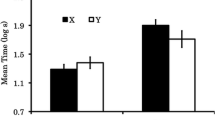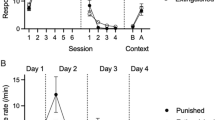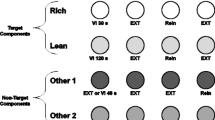Abstract
These experiments compare resistance to reinforcement and resistance to extinction techniques for measuring inhibitory stimulus control by S — following discrimination training. In Experiment 1, rats received 24 sessions of training on a discrimination between two lights and then the inhibitory properties of S — were measured with either the resistance to reinforcement or resistance to extinction technique. Acquisition or extinction of responding to the former S — was compared to that to a novel stimulus. As expected, the resistance to extinction technique indicated more inhibition and the size of the difference increased throughout three sessions of testing. In Experiment 2, rats received 15 or 30 days of training on the discrimination problem and then all of the rats received combined-cues tests of the inhibitory properties of S —. Following 2 days of additional discrimination training, the rats were assigned to resistance to reinforcement or resistance to extinction test conditions. Resistance to extinction again indicated more inhibition than resistance to reinforcement at both levels of training, and combined-cue testing indicated the highest levels of inhibition. At the lower level of training, resistance to reinforce-ment gave no evidence of any inhibition. These data were interpreted as showing that the resistance to reinforcement technique is relatively insen-sitive, particularly to low levels of inhibition. This finding is consistent with the notion that discrimination training renders S — more condition-able as well as inhibitory.
Similar content being viewed by others
References
GUTMAN, A. (1977). Positive contrast, negative induction, and inhibitory stimulus control. Journal of the Experimental Analysis of Behavior, 27, 219–233.
GUTMAN, A., & MAIER, S. F. (1978). Operant and Pavlovian factors in cross-response transfer of inhibitory stimulus control. Journal of the Experimental Analysis of Behavior, 9, 231–254.
HEARST, E. (1978). Stimulus relationships and feature selection in learning and behavior. In S. H. Hulse, H. Fowler, & W. K. Honig (Eds.), Cognitive processes in animal behavior, (pp. 51–88). Hillsdale, NJ: Lawrence Erlbaum.
HEARST, E., BESLEY, S., & FARTHING, G. W. (1970). Inhibition and the stimulus control of operant behavior. Journal of the Experimental Analysis of Behavior, 14, 373–409.
HEARST, E., & JENKINS, H. M. (1974). Sign tracking: The stimulus-reinforcer relation and directed action. Paper presented at the meeting of the Psychonomic Society, Austin, TX.
KARPICKE, J., & HEARST, E. (1975). Inhibitory control and errorless learning. Journal of the Experimental Analysis of Behavior, 23, 159–166.
LEEMING, F. C. (1982). The resistance to reinforcement technique for measuring inhibition. The Psychological Record, 32, 435–444.
LEEMING, F. C. (1983). Inhibitory blocking with successive stimulus presentations. The Psycholog-ical Record, 33, 257–268.
MACKINTOSH, N. J. (1975). A theory of attention: Variations in the associability of stimuli with reinforcement. Psychological Review, 82, 276–298.
PEARCE, J. M., & HALL, G. (1980). A model for Pavlovian learning: Variations in the effectiveness of conditioned but not of unconditioned stimuli. Psychological Review, 87, 532–552.
RESCORLA, R. A. (1969). Pavlovian conditioned inhibition. Psychological Bulletin, 72, 77–94.
WILLIAMSON, D. A., LEEMING, F. C., SEWELL, W. R., & ROBINSON, K. D. (1979). The detection of inhibition using the resistance to reinforcement method. The Psychological Record, 29, 231–244.
Author information
Authors and Affiliations
Rights and permissions
About this article
Cite this article
Leeming, F.C., Larson, C.F. & Riddell, M.D. Resistance To Extinction vs. Resistance to Reinforcement to Measure Inhibition. Psychol Rec 34, 417–425 (1984). https://doi.org/10.1007/BF03394884
Published:
Issue Date:
DOI: https://doi.org/10.1007/BF03394884




